Camp Letterman General Hospital Battle of Gettysburg Army of the
Potomac Photographs Pictures American Civil War diseases wounds gangrene amputation amputee leg arm medical procedures practices
Camp Letterman General Hospital
| Camp Letterman General Hospital |
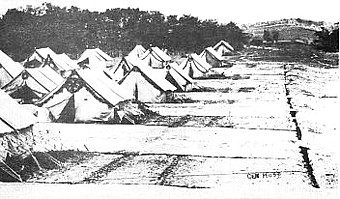
|
| (National Archives) |
At the close of the Battle of Gettysburg, approximately 22,000 wounded soldiers of both armies required medical treatment. Some of the more fortunate
with minor wounds were able to be treated and quickly removed from the area though more serious wounded could not be moved.
(Left) Picture of tents at Camp Letterman General Hospital, photographed by the Tyson Brothers in September
1863. Each tent is decorated with fresh boughs of cedar to ward off insects and cleanse the air. The town of Gettysburg is
in the distance at the far right.
Temporary "field hospitals" were established wherever there was a source of water and shelter, and every
building was fair game: churches, farm buildings, private homes, and barns. For some, the only shelter available was provided
by trees or a piece of canvas strung between poles. Wounded were everywhere, including a number of southern wounded left behind
when the Confederates retreated. Lee's Medical Department attempted to transport many of their wounded back to Virginia though
their suffering was terrible. Miles of wagons overloaded with wounded men bumped and jolted over muddy roads toward the Potomac,
each bump causing more misery than can be imagined. Wounded southerners left behind may have been more fortunate. They fell
into Union hands and were treated with equal care by Union surgeons already overworked by the vast amount of Union wounded.
The hardships of the injured were only matched by the exhaustion of overworked doctors, attendants, and ambulance drivers.
Regimental surgeons began the grisly task of sorting and treating the wounded while the battle raged. Surgical operations
took place in the parlors of homes, in barns, or in the front yard of a farmer's house after which the wounded were set aside
to be nursed by a handful of attendants. A steady flow of injured were treated by tireless surgeons who only took minimal
rest and food during the days of the battle and the weeks that followed. Medical supplies began to run low as the battle ground
to its bloody end and the situation was close to becoming a crisis.
| Dr. Jonathan Letterman |
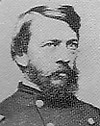
|
| (Vast Sea of Misery) |
Treatment of the wounded left at Gettysburg was left up to the mercy of the Army of the Potomac. Dr. Jonathan Letterman, Medical Director for the Army of the Potomac, was not totally unaware of the
difficulties in proper treatment of so many wounded and the difficulties his staff of doctors and regimental surgeons faced.
Letterman had learned from his experiences in many difficult campaigns that proper medical care required swift action and
the immediate disposal of staff, supplies and equipment within the battle area. Letterman also depended on the services of
charitable organizations such as the US Christian Commission and the US Sanitary Commission to provide medical supplies and
personnel to assist with temporary field hospitals and transport of the injured and maimed. As early as the first evening
of the battle, Letterman had medical supplies, tents, and provisions on the way to Adams County. Dr. Letterman allowed regimental
surgeons to do their work at the numerous temporary field hospitals, but knew that the hundreds of hospitals made support
difficult on an already overburdened supply train. He issued orders on July 5, 1863, to establish a general hospital in the
Gettysburg area and provide transportation and supplies to the site for treatment of the wounded. In his honor, the temporary
hospital was named after him.
The site chosen for the vast hospital camp was on the George Wolf Farm, roughly
one and one-half miles east of Gettysburg on the York Pike. The farm was adjacent to the main road and the railroad where
a depot was established. Arriving trains would deliver a continual flow of supplies for the Gettysburg camp and transport
convalescents to permanent hospitals in Philadelphia, Baltimore and Washington. Wolf's farm had good drainage, water and a
ready source of firewood.
| Hospital wards at Camp Letterman, September 1863. |
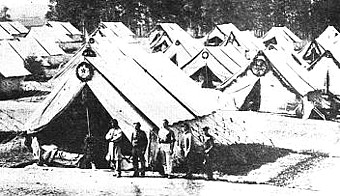
|
| (National Archives) |
The hospital was ready by mid-July and staffed with a small army of surgeons,
nurses, cooks, quartermaster and supply clerks while a detachment of infantry was detailed as camp guards to look after stores
and hospitalized Confederate prisoners. A steady stream of ambulances brought injured Yanks and Rebs to the camp where each
man was assigned to a bed in one of the large tents or wards. Miss Sophronia Bucklin was one of the first nurses assigned
to Camp Letterman and arrived in mid-July, ten days after the camp was opened. "The hospital lay in the rear of a deep wood,
in a large open field a mile and a half from Gettysburg, and overlooking it, the single file of rail which connected the battletown
with the outer world... The hospital tents were set in rows, five hundred of them, seeming like great fluttering pairs of
white wings, brooding peacefully over those up between these rows in order that they might dry quickly after summer rains.
The ground, now sodded, soon to be hardened by many feet, was the only floor in the wards."
| Open air surgery at Camp Letterman. |
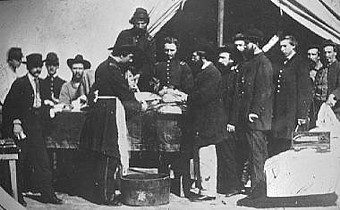
|
| (National Archives) |
Though Camp Letterman was primitive by modern standards, the hospital was vast and impressive. One tent
had upwards of 40 folding cots with mattresses and linen sheets, a real luxury for soldiers that had lain on the hard ground
or in hay lofts since being wounded. Nurses were assigned to a set of wards to bathe and feed the patients. A large cook house,
built in the woods at the central heart of the camp, supplied soups, stews, and warm bread for meals. Warehouse tents were
erected near the railroad to accommodate tons of supplies that arrived by railroad. A temporary morgue and cemetery were also
established near the camp and deaths were quickly dealt with by a Christian burial attended to by an army chaplain. Agents
and representatives of the US Sanitary Commission and US Christian Commission arrived and set up their respective headquarters
at the camp. Both agencies provided services to the patients with nursing care as well as religious inspiration. Surgeons
assigned to the camp worked around the clock treating the more seriously wounded while the ambulatory cases were set aside
for transferal to permanent hospitals. Camp Letterman was filled to capacity by late July and eventually hosted over 1,600
patients. Hundreds more were treated by the medical staff in some of the temporary hospitals in Gettysburg churches and homes
before they were emptied.
| Wounded Confederates convalesce at Camp Letterman. |
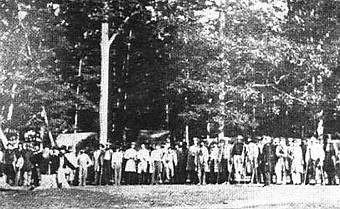
|
| National Archives) |
Surgeons worked long hours in treating the wounded. Amputations were performed in front of a surgical tent
pitched near the end of the rows of hospital tents. The surgeons were so skilled that the removal of an arm or a leg was accomplished
in a matter of minutes and the unlucky soldier returned to his bed within the hour. Tools were washed with cold water and
not properly sterilized, a common practice for that time. This lack of knowledge of bacteria and germs made for frightful
cases of gangrene and tetanus, and infection was a major problem in the camp. Already weakened from the effects of wounds
and surgery, those patients who suffered infections were also subjected to the added effects of diarrhea and dysentery.
Despite the threat of infection and effects of poor diet, most of the camp's
patients weathered the surgeon's knife and survived their ordeal. While army medical staff labored in the camp, members of
the Sanitary Commission worked near the railway depot, assisting in the transportation of wounded bound for permanent hospitals.
Transportation was limited due to the single railroad line that entered Gettysburg and it was often a long wait until the
next train arrived. One volunteer for the US Sanitary Commission recorded the task of caring for the wounded:
|
"The surgeon in charge of our camp, with his faithful dresser and attendants,
looked after all their wounds, which were often in a most shocking state, particularly among the rebels. Every evening and
morning they were dressed. Often the men would say, 'That feels good, I haven't had my wound so well dressed since I was hurt.'
Something cool to drink is the first thing asked for after the long dusty drive, and pailfuls of tamarinds and water, 'a beautiful
drink,' the men used to say, disappeared rapidly among them.
"After the men's wounds were attended to, we went round giving them clean clothes, had basins and soap and
towels, and followed these with socks, slippers, shirts, drawers, and those coveted dressing gowns. Such pride as they felt
in them! Comparing colors and smiling all over as they lay in clean and comfortable rows ready for supper, 'on dress parade,'
they used to say. And then the milk, particularly if it were boiled and had a little whiskey and sugar, and the bread, with
butter on it, and jelly on the butter- how good it all was, and how lucky we felt ourselves in having the immense
satisfaction of distributing these things. Two Massachusetts boys, I especially remember, for the satisfaction with which
they ate their pudding. I carried a second plateful up to the cars, after they had been put in, and fed one of them till he
was sure he had had enough. Young fellows they were, lying side by side, one with a right and one with a left arm gone." |
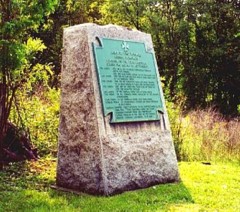
(Left) Picture of US War Department marker at the site of Camp Letterman General
Hospital on the York Road near Gettysburg. Gettysburg NMP.
Camp Letterman also experienced its share of visitors including families in
search of loved ones. Adams Countians and curious civilians from Hanover stopped by the hospital to gawk at wounded Confederates
reclining in the open air by their hospital tents. Treated with equal care by the Union surgeons and nurses, the southerners
were later transported to northern prison camps. Many recovered from the effects of their wounds, after which they were paroled
and exchanged to return to Confederate service.
Less than 100 patients remained at Camp Letterman by November 10 and it was
officially closed a few weeks later. Tents were removed, remaining supplies taken to Washington, and the sole cook house dismantled.
George Wolf returned his farm to its original purpose with only the camp graveyard remaining as a reminder of what had been
established there. There had been remarkably few problems with the hospital and Dr. Letterman's goals had been met in treating
and removing the wounded from Gettysburg and the surrounding farms. Camp Letterman was a role model for future military field
hospitals and as The Adams Sentinel reported, "The arrangements of the Camp Hospital were so perfect and such constant
and prompt attention given to the wants of the wounded, that the sufferings incident to those terrible results of war have
been much ameliorated and the brave soldiers, who were the sufferers, will never forget Gettysburg."
Inevitable commercial growth in Adams County and around Gettysburg has obliterated
a majority of the site of Camp Letterman. All traces of the camp where so many men were treated for their wounds at Gettysburg
are gone except for a small portion of the wood lot adjacent to a memorial tablet, erected by the United States War Department
prior to 1914, located on Rt. 30. Union dead in the camp graveyard were removed to the Soldiers National Cemetery in 1864
and southern remains were exhumed between 1872 and 1873 for relocation to southern cemeteries.
Sources: Gettysburg National Military Park;
Library of Congress; National Archives and Records Administration; National Park Service; Official Records of the Union and Confederate Armies
Recommended Reading: Debris
of Battle: The Wounded of Gettysburg.
Description: When the battle at Gettysburg ended, over 21,000 Union
and Confederate wounded lay helpless in the shattered woods and decimated fields surrounding the small town. As both armies
withdrew they left the care of the wounded--and the burial of the dead--to a stunned citizenry. Amazingly, an unprecedented
number of volunteers from both the North and South, including the U.S. Sanitary Commission and the U.S. Christian Commission,
soon descended upon the isolated town, bringing with them much-needed medical attention, supplies, and food. Continued below…
Reviews:
"A deeply moving, really
wonderful book." -- Thomas Fleming, author and historian
"Adds a fascinating coda
to the military campaign."
"Adds a fascinating coda to the
military campaign." -- Gary W. Gallagher, in Civil War Magazine
About the Author: Gerard A. Patterson
is the author of "From Blue to Gray: The Life of Confederate General Cadmus M. Wilcox," "Justice or Atrocity: Gen. George
E. Pickett and the Kinston,
N.C. Hangings," and "Rebels from West Point: The 306 U.S.
Military Academy Graduates Who Fought for the Confederacy." Patterson has contributed more than 30 articles to "Civil War
Times Illustrated," "American History," and other history publications.
Recommended Reading: This Republic of Suffering: Death and the
American Civil War. Editorial Review from Publishers Weekly: Battle is the dramatic centerpiece of Civil War history;
this penetrating study looks instead at the somber aftermath. Historian Faust (Mothers of Invention) notes that the Civil
War introduced America to death on an unprecedented scale and of an unnatural kind—grisly, random and often ending in
an unmarked grave far from home. Continued below.
She surveys the many ways the Civil War generation coped with the trauma: the concept of the Good Death—conscious,
composed and at peace with God; the rise of the embalming industry; the sad attempts of the bereaved to get confirmation of
a soldier's death, sometimes years after war's end; the swelling national movement to recover soldiers' remains and give them
decent burials; the intellectual quest to find meaning—or its absence—in the war's carnage. In the process, she
contends, the nation invented the modern culture of reverence for military death and used the fallen to elaborate its new
concern for individual rights. Faust exhumes a wealth of material—condolence letters, funeral sermons, ads for mourning
dresses, poems and stories from Civil War–era writers—to flesh out her lucid account. The result is an insightful,
often moving portrait of a people torn by grief.
Editor's Choice: A Strange and Blighted Land: Gettysburg, The Aftermath of a Battle. Description:
The more dismal side of the Gettysburg campaign is covered: burials of Union and Confederate corpses, removal of the 3,000
horses killed, care of the wounded, descriptions of field hospitals, disposition of POWs, cleanup of the battle ground, collection
of weapons, early relic hunters, battlefield guides, and a tour of the grim and bloody fields as described by a host of early
visitors.
Recommended Reading: Gangrene and Glory: Medical Care during the American Civil War (University
of Illinois Press). Description: Gangrene and Glory covers practically every aspect of the 'medical related issues'
in the Civil War and it illuminates the key players in the development and advancement of medicine and medical treatment.
Regarding the numerous diseases and surgical procedures, Author Frank Freemon discusses what transpired both on and off the
battlefield. The Journal of the American Medical Association states: “In Freemon's
vivid account, one almost sees the pus, putrefaction, blood, and maggots and . . . the unbearable pain and suffering.”
Continued below...
Interesting historical accounts,
statistical data, and pictures enhance this book. This research is not limited to the Civil War buff, it is a must read for
the individual interested in medicine, medical procedures and surgery, as well as some of the pioneers--the surgeons that
foreshadowed our modern medicine.
Recommended Reading: Bleeding
Blue and Gray: Civil War Surgery and the Evolution of American Medicine (Hardcover) (416 pages) (Random House). Description:
A landmark chronicle of Civil War medicine, Bleeding Blue and Gray is a major contribution
to our understanding of America’s bloodiest conflict. Indeed, eminent surgeon
and medical historian Ira M. Rutkow argues that it is impossible to grasp the harsh realities of the Civil War without an
awareness of the state of American medicine at the time. At
the outset of the war, the use of ether and chloroform remained crude, and they were often unavailable in the hellish conditions
at the front lines. As a result, many surgical procedures were performed without anesthesia in the compromised setting of
a battleground or a field hospital. This meant that “clinical concerns were often of less consequence,” writes
Rutkow, “than the swiftness of the surgeon’s knife.” Continued below...
Also, in the 1860s, the existence
of pathogenic microorganisms was still unknown–many still blamed “malodorous gasses” for deadly outbreaks
of respiratory influenza. As the great Civil War surgeon William Williams Keen wrote, “we used undisinfected instruments
from undisinfected plush-lined cases, and still worse, used marine sponges which had been used in prior pus cases and
had been only washed in tap water.” Besides the substandard
quality of wartime medical supplies and techniques, the combatants’ utter lack of preparation greatly impaired treatment.
In 1861, the Union’s
medical corps, mostly ill-qualified and poorly trained, even lacked an ambulance system. Fortunately, some of these difficulties
were ameliorated by the work of numerous relief agencies, especially the United States Sanitary Commission, led by Frederick
Law Olmsted, and tens of thousands of volunteers, among them Louisa May Alcott and Walt Whitman. From the soldiers who endured the ravages of combat to the government officials who directed
the war machine, from the good Samaritans who organized aid commissions to the nurses who cared for the wounded, Bleeding
Blue and Gray presents a story of suffering, politics, character, and, ultimately, healing. About the Author: Ira
M. Rutkow is a clinical professor of surgery at the University
of Medicine and Dentistry of New Jersey. He also holds a doctorate of
public health from Johns Hopkins
University. Dr. Rutkow’s Surgery: An Illustrated History was a
New York Times Notable Book of the Year. He and his wife divide their time between New
York City and the Catskills.
Recommended Reading:
Civil War Medicine: Challenges and Triumphs (Hardcover: 475 pages). Description: Nothing is left unstudied! Alfred Jay Bollet covers a
multitude of areas in the world of the medical care/treatment featuring early war ill-preparation, being overwhelmed, medical
science, surgery, amputations, wounds, hospitals, drugs, diseases, prison camps and notable individuals of the era. Every
chapter offers added insight via biographies on individuals that had influence on the subject discussed—thus adding
more intrigue to this book. This book is considered very comprehensive and fair to all parties involved…often bringing
to light the importance of doctors and nurses through out the entire war and its aftermath. Continued below...
Numerous sidebar
articles appear throughout the text to embellish points of interest and a nice appendix is provided, as well as countless
charts offering statistical data. Bollet's style is very reader friendly - you don't have to be that “med student”
to enjoy it!
|

